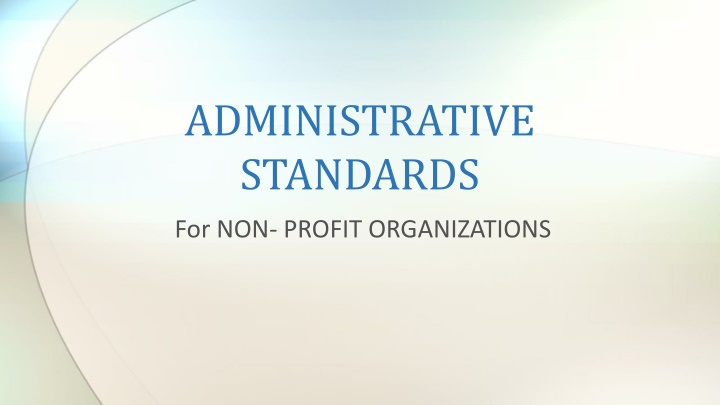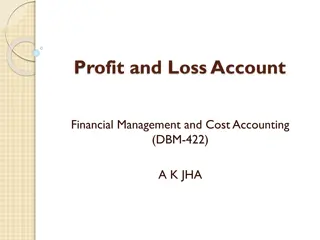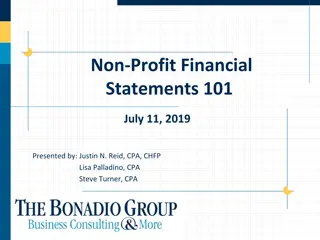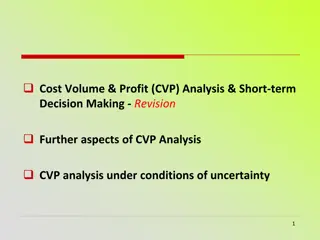
Effective Administration Standards for Non-Profit Organizations
Establishing a nonprofit organization involves creating an advisory committee, defining its purpose and mission, forming a dedicated board of directors, and ensuring compliance with legal requirements and regulations. The advisory committee serves a critical role in guiding the organization through complex situations, while the board of directors takes on ownership and responsibility for setting goals and maintaining legal status. Key considerations include mission alignment, board structure, and adherence to legal standards such as residency requirements and regulatory compliance.
Download Presentation

Please find below an Image/Link to download the presentation.
The content on the website is provided AS IS for your information and personal use only. It may not be sold, licensed, or shared on other websites without obtaining consent from the author. If you encounter any issues during the download, it is possible that the publisher has removed the file from their server.
You are allowed to download the files provided on this website for personal or commercial use, subject to the condition that they are used lawfully. All files are the property of their respective owners.
The content on the website is provided AS IS for your information and personal use only. It may not be sold, licensed, or shared on other websites without obtaining consent from the author.
E N D
Presentation Transcript
ADMINISTRATIVE STANDARDS For NON- PROFIT ORGANIZATIONS
ADVISORY COMMITTEE Different from the Board of Directors May become the founding Board of Directors Guides the organization through the legal system In complex situations, legal assistance may be necessary Staying legal thru the process can be difficult
PURPOSE & MISSION The purpose of a charitable nonprofit must be for the public interest and common good. It should establish a single mission and a set of goals and programs that will help to accomplish that mission. The organization should analyze what it wants to do, whom it wants to serve and reach, and how it wants to affect society. Mission Statement will guide the organization through its formation, program development, growth and change.
BOARD OF DIRECTORS The Board of Directors will assume much of the responsibility of the non-profit organization. Will assume the role of ownership of the organization. They will determine the direction and goals of the organization and set forth precedents/requirements for future board members. Ensure that the organization maintains a legal status
BOARD OF DIRECTORS Shall be residents of the area served by the organization Represent social, economic, linguistic, ethnic, and racial target population Must submit DOB so that FNB can check the NDL Will consist of President, Vice-President, Secretary, Treasurer, other members. Minimum of 3 board members A non-profit organization shall not: Employ a person related to a board member by consanguinity or affinity within the third degree This includes, but is not limited to: spouse, mother, father, brother, sister, grandparents, aunts, uncles, niece, nephew, first cousins, mother-in-law, father-in law, brother or sisters- in- law
BOARD OF DIRECTORS Boards shall ensure that the non-profit organization complies with applicable legal requirements and regulations of all governmental (IRS) and legally authorized agencies under whose authorities it operates. Including but not limited to: Equal Employment Opportunity Workers Compensation Unemployment Insurance Affirmative Action Safety, licensing, etc.
ARTICLES OF INCORPORATION Review of current Articles of Incorporation that meet all of the legal requirements of the governmental jurisdiction in which the contractor is located. Including: Formal name of the entity The location It s purpose How the organization will be managed The purpose of the organization, and the requirements it must follow for exemption.
ORGANIZATION BY-LAWS The By-Laws serve as the rule book for a non-profit organization. Must be filed with appropriate local, state, federal body. At a minimum shall include: Membership (types, qualification, rights, duties etc.); Size of Board of Directors; Method of selection & removal; Duties and responsibilities of officers; Committees; Quorums; Recording of minutes; Method of amending By-Laws.
BUISNESS PLAN & BUDGET A business plan for non-profits can provide a sense of direction for the organization as it develops. A plan should include what the organization s goals are, what programs it will operate, where it will get funding, how it will be staffed, and more. A budget plan should include: Funding Sources: Where will funding come from? Funding scope: Will programs rely on grants, donations, state, &/or federal contracts? Planned expenses; What costs will the organization incur to operate its programs? A business plan & budget are not only useful in thinking through the structure or the organization but are required by the IRS.
MEETING OF THE MINDS A permanent record or Minutes of the meeting of the non- profit organization s board are required in order to accurately record the decisions made and actions taken. The minutes shall include, but not be limited to: Meeting date Names of members attending Topics discussed Decisions & actions reached & taken Attachment of any documents referenced Minutes shall be signed and approved by an officer of the Board.
FEDERAL & STATE FILING Non-profit organizations should have an EIN number or Federal ID Number. 501(c)(3) status certificate from the IRS Current W-9 form filed with state department of finance. 501 c (3) organizations are required to file a Form 990 report with IRS each year. [Religious organizations such as churches & church related organizations and those with gross revenues of less than $50,000 are exempt] CYFD requires all of this documentation to be in place in order to send payment to any non-profit organization and will be checked in future program reviews.
What questions do you have?






















